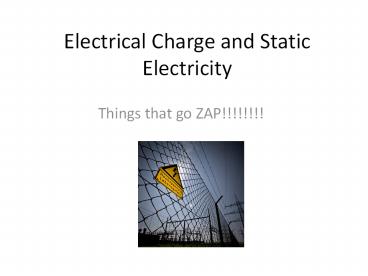Electrical Charge and Static Electricity - PowerPoint PPT Presentation
1 / 11
Title:
Electrical Charge and Static Electricity
Description:
If you double the distance between two objects the electric force is one-fourth as strong ... Charge can be transferred by friction, by contact and by induction ... – PowerPoint PPT presentation
Number of Views:116
Avg rating:3.0/5.0
Title: Electrical Charge and Static Electricity
1
Electrical Charge and Static Electricity
- Things that go ZAP!!!!!!!!
2
Electric Charge
- Electrical energy is the energy associated with
electric charges - An electric charge is a property that causes
subatomic particles such as protons and electrons
to attract or repel each other - Protons have a positive charge ()
- Electrons have a negative charge (-)
3
Electric Charge
- When an atom gains an electron it is negatively
charged - When an atom loses an electron it is positively
charged - A net electric charge is produced when there is
too many or too few electrons
4
Coulomb
- The SI unit for electric charge is the coulomb
- It takes 6.24 x 1018 electrons to make 1 coulomb
- A lightning bolt is 10 to 20 coulombs
- A flash camera uses about 0.025 coulombs to
produce a flash
5
Electric Forces
- Like charges repel each other where opposite
charges attract - Electric force is the force of attraction or
repulsion between electrically charged objects - If you double the electric charge of an object
you double the electric force - If you double the distance between two objects
the electric force is one-fourth as strong
6
Electric Fields
- The electric field is the effect an electric
charge has on other charges in the space around
it - The strength of an electric field depends on the
amount of charge that produces the field and the
distance from the charge
7
Static Electricity and Charging
- Static electricity includes how charge is
transferred between objects - Law of conservation of charge states that the
total charge in an isolated system is constant - Charge can be transferred by friction, conduction
and induction
8
Friction
- An example of charging by friction is rubbing a
balloon against your hair - The electrons will move from your hair to the
balloon - The balloon now has a negative charge and your
hair has a positive charge
9
Conduction
- A Van de Graff generator ( a charged metal
sphere) will cause a charge by contact - There is a reduction in the charge of the Van de
Graff generator because some has gone to the
persons hair - Your hair will stand on end due to the charge
10
Induction
- When you go to touch a metal doorknob after
walking across a carpet is induction - Your hand has a negative charge from walking
across the carpet - The electrons in your hand repel the electrons in
the doorknob - Induction is a transfer of charge between
materials without contact
11
Static Discharge
- Static discharge occurs when a pathway through
which charges can move forms suddenly - When you go to touch the doorknob the air between
your finger and the knob is charged - This allows electrons to flow from your hand to
the doorknob































